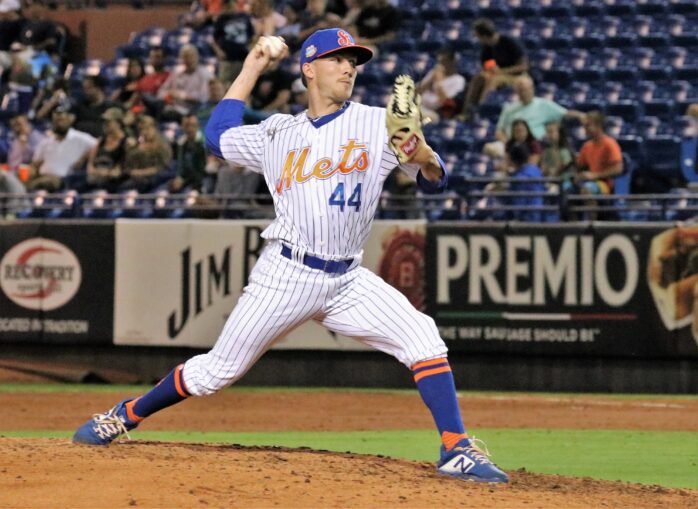
Photo by Ed Delany, MMO
Ryley Gilliam, RHP
Position: Reliever
Bats/Throw: R/R
Age: 23 (August 11, 1996)
Acquired: 2018 June Amateur Draft– Round 5, Pick 6, Overall: 140
2019 Stats: 5-0, 38 2/3 IP, 13.03 K/9, 4.19 BB/9
On January 9, the Mets announced that they had invited 15 non-roster players to Major League Spring Training. One of these players was Ryley Gilliam, the Mets’ 5th round pick (140th overall) of the 2018 draft.
The 5’10”, 170-pound right-hander was born in Georgia and grew up playing baseball at Kennesaw Mountain High School, from where he committed to play collegiate ball at Clemson.
Gilliam had a tough freshman year with Clemson, moving in and out of the bullpen across 31 innings in which he struggled with his command, walking more batters than he struck out.
Gilliam showed progress during his sophomore year after transitioning to a full-time bullpen role, mostly thanks to a spike in K’s and a decreased walk rate. However, he really burst onto the scene in his junior year– a 1.41 ERA launched Gilliam onto many draft boards, and the 140th pick ended up signing with the Mets for a $550,000 bonus.
Since joining the Mets, one thing the now 23-year old has not done is follow the traditional prospect path. He started off in low-A ball, as many do, posting an impressive 16.1 K/9 and 2.08 ERA in 17 1/3 innings (17 appearances) with the Brooklyn Cyclones. Though his walks were a bit shaky (6.75 per 9 IP), many pointed to an increased workload, having thrown over 35 innings with Clemson for the beginning of the season.
Sure enough, Gilliam started 2019 with the High-A St. Lucie Mets and walked just two in 10 1/3 innings. He quickly proved to be playing above the level of competition, impressing with 13.5 K/9 and a minuscule 0.87 FIP in his short stint with St. Lucie.

Photo by Bill Mitchell
This earned Ryley an April call-up to Double-A, where despite giving up a few more runs (4.34 ERA), his strikeout numbers remained consistently high, giving Mets fans reason to believe in the young right-hander.
After just two months with the Rumble Ponies, Gilliam continued his quick rise, getting the call-up to Triple-A in mid-June. Ryley got knocked around a bit in Syracuse, as he was bitten by the long ball (3 HR in 9 ⅓ IP) and struggled with his command (9 walks). However, the strikeouts were still there (11 K), and it’s possible that Gilliam had trouble getting used to the new baseball that is used above Double-A, as many young pitchers do.
After an injury cut his regular season short in July, Gilliam was invited to play in the Arizona Fall League, pitching out of the bullpen for the Scottsdale Scorpions. Many headlines from this fall focused on the Mets’ prized Andres Gimenez, who hit very well for the Scorpions, but Gilliam impressed just as much.
Over seven appearances, the right-hander allowed just one earned run in 9 1/3 innings (0.96 ERA). The strikeouts were still there (11), and the high walk total that had bugged him in Triple-A came down significantly (2). A very promising end to an up-and-down season for Gilliam.
Gilliam is a mid-90’s fastball and hard curve pitcher. The spin rate on his fastball and curve is among the top echelon in the Mets system at 2400 rpm and 2600 respectively. His quick arm action improves the perceived velocity on his fastball.
Key Numbers
Gilliam is ranked as the Mets No. 16 prospect according to MLB Pipeline.
The former Clemson closer has struck out 35.1% of the batters he’s faced in pro ball.
Right-handers are just 21-for-110 (.191 AVG) with two home runs and 48 strikeouts against Gilliam.
Career Highlights
2020 Outlook
As the roster stands now, the road to an opening day spot in the bullpen seems bumpy for Gilliam. The Mets have several players who are locks for the bullpen– Edwin Diaz, Seth Lugo, recently signed Dellin Betances, Jeurys Familia, Justin Wilson, and Brad Brach, all of whom are on major league deals. Robert Gsellman will likely start the season with the big league club if he is healthy, though he does have one option remaining.
As for that eighth spot, manager Carlos Beltran could go with one of Michael Wacha, Steven Matz, or Rick Porcello, since there are two spots in the rotation for three of those guys. Of course, it’s baseball– anything could happen. Someone like Gilliam could have an impressive spring and fill that opening day spot.
This, though, is unlikely. Despite an impressive fall league showing, Gilliam will probably spend some time in triple-A before joining the Mets, due to his lack of experience, and the current structure of the bullpen. On the other hand, we know from experience just how much underperformance and injuries can change the look of a team’s bullpen, so Gilliam finding himself in a 2020 late-inning role for the Metropolitans may be more likely than we think.















